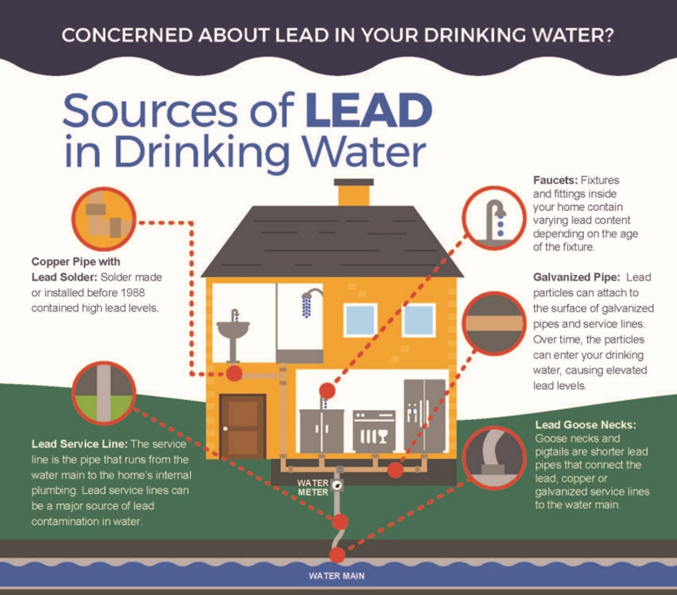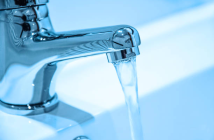FOR IMMEDIATE RELEASE – THREE RIVERS, MI
NOTICE TO RESIDENTS OF THE CITY OF THREE RIVERS
IMPORTANT INFORMATION ABOUT LEAD IN YOUR DRINKING WATER
Public Info (PDF) | Steps to Reduce Exposure | Additional Resources
CITY OF THREE RIVERS HAS EXCEEDED THE ACTION LEVEL FOR LEAD. Lead can cause serious health and development problems, especially for pregnant women and young children. Please read this information closely to see what you can do to reduce lead in your drinking water.
This notice is brought to you by City of Three Rivers
Water Supply Serial Number: 06610
Distribution Date: August 24, 2024
Health Effects of Lead
Lead can cause serious health and development problems. It can cause damage to the brain and kidneys, and can interfere with the production of red blood cells that carry oxygen to all parts of your body. The greatest risk of lead exposure is to infants, young children, and pregnant women. Scientists have linked the effects of lead on the brain with lowered IQ in children. Adults with kidney problems and high blood pressure can be affected by low levels of lead more than healthy adults. Lead is stored in the bones, and it can be released later in life.
During pregnancy, the child receives lead from the mother’s bones, which may affect brain development. Although other sources of lead exposure exist, such as lead paint, and lead contaminated dust, City of Three Rivers is contacting you to reduce your risk of exposure to lead in drinking water. If you have questions about other sources of lead exposure, please contact Branch Hillsdale St. Joseph Community Health Agency at 269-273-2161.
Sources of Lead
Lead is a common metal found in the environment. Drinking water is one possible source of lead exposure due to the widespread use of lead in plumbing materials. EPA estimates that drinking water can make up 20 percent or more of a person’s potential exposure to lead. Infants who consume mostly mixed formula can receive 40 percent to 60 percent of their exposure to lead from drinking water.
The action level is 15 parts per billion (ppb) for lead and 1.3 parts per million (ppm) for copper. The action level is a measure of corrosion control effectiveness. It is not a health-based standard. To meet the requirements of the Lead and Copper Rule, 90 percent of the samples collected must be below the action level. The following table summarizes the lead and copper data collected during the most recent monitoring period:
For additional information including the most recent sampling information, as well as other resources and information, click the Public Information (PDF) link below:
Public Information (PDF)
_
Check whether your home has a lead service line. Homes with lead service lines have an increased risk of having high lead levels in drinking water. Please contact City of Three Rivers for more information about your home’s service line.
Steps you can take to reduce your exposure to lead in your water:
- Run your water to flush out lead. The more time water has been sitting in your home’s pipes, the more lead it may contain. Therefore, if your water has not been used for several hours, run the water before using it for drinking or cooking. This flushes lead-containing water from the pipes.
-
- If you do not have a lead service line, run the water for 30 seconds to two minutes, or until it becomes cold or reaches a steady temperature.
- If you do have a lead service line, run the water for at least five minutes to flush water from both the interior building plumbing and the lead service line.
Additional flushing may be required for homes that have been vacant or have a longer service line. Your water utility can help you determine if longer flushing times are needed.
- Everyone can consider using a filter to reduce lead in drinking water. MDHHS recommends that residents use a certified lead-reducing drinking water filter if their home has or if they are uncertain if it has one of the following.
-
- Lead or galvanized plumbing
- A lead service line carrying water from the street to their residence.
- Copper plumbing with lead solder before 1988 (EGLE recommendation).
- Old faucets and fittings that were sold before 2014.
Use the filter until you are able to remove sources of household lead plumbing, such as:
-
- Replace pre-2014 faucets.
- Get a lead inspection and replace needed plumbing.
Look for filters that are tested and certified to NSF/ANSI Standard 53 for lead reduction and NSF/ANSI Standard 42 for particulate reduction (Class I). Some filter options include a pour-through pitcher or faucet-mount systems. If the label does not specifically mention lead reduction, check the Performance Data Sheet included with the device. Be sure to maintain and replace the filter device in accordance with the manufacturer’s instructions to protect water quality.
- Use cold water for drinking and cooking. Do not cook with or drink water from the hot water tap; lead dissolves more easily into hot water.
_ - Use cold water for preparing baby formula. Do not use water from the hot water tap to make baby formula. MDHHS recommends using bottled water or a filter certified to reduce lead to prepare baby formula.
_ - Do not boil water to remove lead. Boiling water will not reduce lead levels.
_ - Consider purchasing bottled water. The Food and Drug Administration (FDA) regulates bottled water. The bottled water standard for lead is 5 ppb.
_ - Get your child tested. Contact your local health department or healthcare provider to find out how you can get your child tested for lead if you are concerned about exposure. Your local health agency is Branch Hillsdale St. Joseph Community Health Agency, 269-273-2161.
_ - Identify older plumbing fixtures that likely contain lead. Older faucets, fittings, and valves sold before 2014 may contain higher levels of lead, even if marked “lead-free.” Faucets, fittings, and valves sold after January 2014 are required to meet a more restrictive “lead-free” definition but may still contain up to 0.25 percent lead. When purchasing new plumbing materials, it is important to look for materials that are certified to meet NSF standard 61. The EPA prepared a brochure that explains the various markings that can indicate that materials meet the new “lead free” definition: https://nepis.epa.gov/Exe/ZyPDF.cgi?Dockey=P100LVYK.txt.
- Clean your aerator. The aerator on the end of your faucet is a screen that will catch debris. This debris could include particulate lead. The aerator should be removed at least every six months to rinse out any debris.
- Test your water for lead. Call us at 269-273-1845 to find out additional information on how to get your water tested for lead. The City is providing free testing for homes with lead or unknown service line materials. If you have a known service line that is neither lead or galvanized connected to lead, water testing is not necessary. If you want to test your service line at your cost, the tests can be coordinated thru the EGLE lab. Their number is 517-335-8184. When requesting a test kit, please make sure to choose the correct lab code based on the three different service line groups.
-
- All homes with service line materials that are known to not be lead or galvanized should use the 1st draw 1L process (lab code 36CCUB; $26)
- All homes with a known lead or galvanized service line should use the 1st/5th methodology to attempt to characterize the risk of exposure associated with the service line. (lab code 36CCUBK; $52)
- All homes with an unknown service line materials should contact City of Three Rivers for more information about your home’s service line or use the 1st/5th methodology to attempt to characterize the risk of exposure associated with the unknown service line. (lab code 36CCUBK; $52)
_
What Happened? _What is Being Done?
City of Three Rivers conducts testing of tap water in homes for lead and copper. This testing takes place at homes with known lead service lines.
Between January and June 2024, we collected samples from 84 homes. 44 were used for the calculation of the 90th percentile. Six homes had results above 15 ppb and the 90th percentile for our samples was above the Action Level for lead.
MDHHS is offering free certified lead-reducing filters and replacement cartridges to eligible households. These criteria are:
- Have or are unsure if they have one of the below:
- Lead or galvanized plumbing.
- A lead service line carrying water from the street to their residence.
- Old faucets and fittings that were sold before 2014.
- Include a Medicaid-enrolled child or children under 19 or Medicaid-enrolled pregnant person.
_
_ -
Filters can be obtained at: City of Three Rivers
Department of Public Services
1015 S. Lincoln Ave.
Three Rivers, MI 49093
Phone: 269-273-1845
Hours: M-F 8 a.m. – 3:30 p.m.Three Rivers City Hall
333 W. Michigan Ave.
Three Rivers, MI 49093
Phone: 269-273-1075
Hours: M,W-F 8 a.m. – 4:30 p.m., and
Tue 11 a.m. – 4:30 p.m._
City of Three Rivers has lead service lines. Lead can enter drinking water when it is in contact with pipes, solder, home/building interior plumbing, fittings and fixtures that contain lead. City of Three Rivers does not currently employ corrosion control treatment to reduce lead leaching. Long term plans are for continued lead service line replacement and installation of corrosion control treatment. The City has been actively replacing lead service lines, when identified during construction, since the 1980’s.
The City has expanded testing for unknown service lines and is completing in-home service line material verifications as part of that process. If you are a City of Three Rivers water customer and would like your service line inspected or would like to have your drinking water tested for lead, contact the City of Three Rivers at 269-273-1845.
_
Posted August 27, 2024
_
__
_
_
_
Additional Resources:
For the City’s annual water quality reports, click here.
Lead Education
- Know the facts about lead
- Well fed means less lead
- Adult exposure to lead
- Pregnant and Breastfeeding Persons
Lead in Drinking Water
- Cleaning your aerators
- How Lead Gets into Drinking Water Video
- How can I protect myself from lead in water? Video
- PUR faucet filter installation
- How to use your PUR pitcher
- BRITA faucet filter installation
- How to use your BRITA pitcher filter




